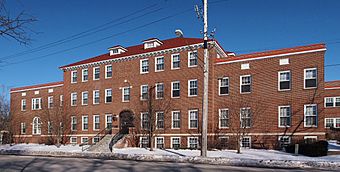North East Neighborhood House facts for kids
Quick facts for kids |
|
|
North East Neighborhood House
|
|

The North East Neighborhood House from the southwest
|
|
| Location | 1929 Second Street NE, Minneapolis, Minnesota |
|---|---|
| Built | 1919 |
| Architect | Kenyon and Maine; Pike and Cook |
| Architectural style | Colonial Revival |
| NRHP reference No. | 01000749 |
| Added to NRHP | July 19, 2001 |
The North East Neighborhood House (NENH) is a special building in the Northeast neighborhood of Minneapolis, Minnesota. It used to be home to a group that helped people in the community. This group started in 1915, created by a church called Plymouth Church.
The idea for helping the community began even earlier, in 1881, with a Sunday School called Immanuel. This school was near Second Street Northeast and Broadway Street Northeast. Later, the school built a new place called Drummond Hall. The church started offering many programs and clubs for people who had moved to Northeast Minneapolis from countries like France, Germany, and Scandinavia.
By the 1910s, many new people were moving to the area, mostly from eastern Europe. These new families also needed help, but most of them were Catholic. They were not interested in the Protestant religious lessons offered by the church. Because of this, fewer people attended, and Drummond Hall had to close in 1913.
Contents
A New Way to Help the Community
Plymouth Church still wanted to help people in northeast Minneapolis. So, they asked for a study to find out what services the neighborhood really needed. The study found that the community needed to feel more connected. People from different countries often had trouble understanding each other.
The study suggested that the church could help new immigrants learn about American ways of life. They could also offer education, health care, and fun activities. The church decided to open a settlement house. A settlement house was a place in a poor neighborhood where people, often from wealthier backgrounds, lived and worked to help the community.
Robbins Gilman Joins the Effort
The church hired Robbins Gilman to lead the new settlement house. He had recently left another settlement house in New York because of his strong ideas about helping workers. The North East Neighborhood House first opened in the old Drummond Hall building. But soon, it moved to a bigger, newer building a few blocks north.
Robbins Gilman's wife, Catheryne, was also a reformer who worked to improve society. She helped with some of the NENH's programs. However, she was more involved in other organizations. When the NENH officially opened on January 20, 1915, it was one of four settlement houses in Minneapolis.
Programs and Growth
The NENH offered many helpful classes. Kids and adults could learn sewing, cooking, carpentry, and dancing. It also gave children a safe place to play and make friends.
Robbins Gilman hired a supervisor for boys and another for girls. This allowed him to focus on his bigger plans for the center. They started a program to help women find jobs, and they also had a day nursery for children. In just three years, the NENH helped over 7,000 women find work. Gilman also opened a dental clinic just for children. As the NENH offered more and more services, it became very popular.
A New Building and Expansion
In 1918, construction began on a brand new building for the NENH. It was designed in a style called neo-Georgian by architects Kenyon and Main. By August of the next year, the NENH staff had moved into their new home.
Throughout the 1920s, the NENH continued to grow and offer even more services. In 1927, two new parts were added to the building. These included a gymnasium for sports and a dormitory, which is like a place for people to stay. When the Great Depression started, the NENH became a very important place. It helped organize aid programs for people in the neighborhood who were struggling.
Later Years and Legacy
Robbins Gilman retired from his work at the NENH in 1948. Lester Shaeffer took over from him, and then Joe Holewa became the leader. Joe Holewa had grown up in the Northeast neighborhood himself.
The second half of the 20th century brought big changes for the NENH and other settlement houses. The government and large private groups started to provide more social services. Also, many of the people who had grown up with the NENH moved away from the neighborhood. New people moving in didn't know as much about what the NENH did.
The North East Neighborhood House kept helping the community until the early 1960s. At that time, it joined with another settlement house called Margaret Barry House. The new combined organization was named East Side Neighborhood Services.
East Side Neighborhood Services moved out of the old Georgian Revival building in 2001. They moved into a new, modern building. The historic 1919 building was then fixed up and is now used as apartments. It was added to the National Register of Historic Places in 2001, which means it's recognized as an important historical site.
 This article incorporates text from MNopedia, which is licensed under the Creative Commons Attribution-ShareAlike 3.0 Unported License.
This article incorporates text from MNopedia, which is licensed under the Creative Commons Attribution-ShareAlike 3.0 Unported License.
Additional Resources
- The North East Neighborhood House Records are available for research at the Minnesota Historical Society.



